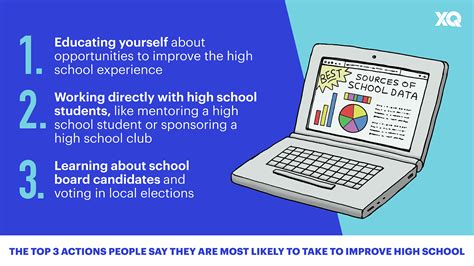The world is changing at an unprecedented pace, and the future of work is uncertain. To prepare students for success in this rapidly evolving landscape, high schools must adapt their curricula and teaching methods. This article will explore the key trends shaping the future of high school and provide concrete examples of how schools are innovating to meet the needs of students.

Personalized Learning
One of the most important trends in education is the move towards personalized learning, which allows each student to learn at their own pace and in a way that meets their individual needs. This can be achieved through a variety of methods, such as online learning, blended learning, and project-based learning.
For example, Summit Public Schools in California has developed a personalized learning platform that allows students to progress through their coursework at their own pace. Students can choose from a variety of learning modules and activities, and they receive real-time feedback on their progress. This approach has helped Summit Public Schools to achieve impressive results, with 94% of students graduating from high school and 85% enrolling in college.
Technology Integration
Technology is playing an increasingly important role in education, and this trend is expected to continue in the future. Schools are using technology to create more engaging learning experiences, personalize instruction, and provide students with access to a wider range of resources.
For example, the Khan Academy is a nonprofit organization that provides free online education to students all over the world. Khan Academy offers a wide range of courses in math, science, computer science, and other subjects. Students can use Khan Academy to learn at their own pace and to review material that they have already learned.
Career and Technical Education
In addition to providing students with a strong academic foundation, high schools are also increasingly focused on preparing students for the workforce. This includes providing students with hands-on experience in a variety of career fields, such as manufacturing, healthcare, and information technology.
For example, the Cincinnati Public Schools in Ohio has partnered with local businesses to create a career and technical education program that provides students with the skills they need to succeed in the workforce. Students in this program can choose from a variety of career pathways, such as automotive technology, construction, and culinary arts.
Global Education
In an increasingly interconnected world, it is more important than ever for students to have a global perspective. High schools are increasingly offering opportunities for students to learn about other cultures and to develop global competencies, such as critical thinking, problem-solving, and communication.
For example, the International Baccalaureate (IB) is a rigorous academic program that prepares students for success in higher education and the global workforce. IB students take courses in a variety of subjects, including language, math, science, and the arts. They also complete a research project and a community service project.
The Future of High School: 10 Trends to Watch
In addition to the four key trends discussed above, there are a number of other trends that are shaping the future of high school. These trends include:
- The rise of online learning
- The use of artificial intelligence (AI) in education
- The increasing focus on social and emotional learning
- The importance of STEM education
- The need for schools to partner with businesses and community organizations
- The growing importance of personalized learning
- The use of technology to create more engaging learning experiences
- The focus on preparing students for the workforce
- The need for global education
- The importance of school climate and culture
Conclusion
The future of high school is bright, but it is also uncertain. Schools must adapt to the changing needs of students and the workforce in order to prepare students for success in the 21st century. The trends discussed in this article provide a roadmap for the future of high school, and schools that embrace these trends will be well-positioned to prepare students for success in a rapidly changing world.
Tips for Preparing for the Future of High School
There are a number of things that students can do to prepare for the future of high school. These include:
- Developing strong academic skills
- Getting involved in extracurricular activities
- Exploring different career options
- Learning about other cultures
- Developing leadership skills
- Being open to new experiences
- Embracing technology
- Preparing for the future of work
- Developing a global perspective
- Being an active citizen
Step-by-Step Approach to Preparing for the Future of High School
Here is a step-by-step approach to preparing for the future of high school:
- Develop a strong academic foundation. This means getting good grades in your classes and developing strong skills in reading, writing, math, and science.
- Get involved in extracurricular activities. Extracurricular activities can help you develop your leadership skills, teamwork skills, and communication skills. They can also help you explore different career options and learn about other cultures.
- Explore different career options. There are many different career options available to you, so it is important to start exploring your options early. Take career assessments, talk to your school counselor, and visit different businesses and organizations.
- Learn about other cultures. The world is becoming increasingly interconnected, so it is important to have a global perspective. Learn about different cultures by reading books, watching movies, and traveling.
- Develop leadership skills. Leadership skills are essential for success in the 21st century. Develop your leadership skills by taking on leadership roles in your school and community.
- Be open to new experiences. The future of work is uncertain, so it is important to be open to new experiences. Be willing to try new things and learn new skills.
- Embrace technology. Technology is playing an increasingly important role in the world, so it is important to embrace technology. Learn how to use technology to your advantage, both in school and in your personal life.
- Prepare for the future of work. The future of work is changing, so it is important to prepare for the future of work. Learn about different career options, develop your skills, and network with people in your field.
- Develop a global perspective. The world is becoming increasingly interconnected, so it is important to develop a global perspective. Learn about different cultures, travel to different countries, and become involved in global issues.
- Be an active citizen. The future of our world depends on the active participation of citizens. Be an active citizen by voting, volunteering, and advocating for the issues that you care about.
Tables
Table 1: High School Graduation Rates
| Year | Graduation Rate |
|---|---|
| 2010 | 80.8% |
| 2015 | 83.9% |
| 2020 | 85.3% |
Source: National Center for Education Statistics
Table 2: College Enrollment Rates
| Year | Enrollment Rate |
|---|---|
| 2010 | 68.3% |
| 2015 | 72.8% |
| 2020 | 74.5% |
Source: National Center for Education Statistics
Table 3: STEM Education in High School
| Year | Percentage of High School Graduates Who Took STEM Courses |
|---|---|
| 2010 | 46.5% |
| 2015 | 50.6% |
| 2020 | 54.2% |
Source: National Science Foundation
Table 4: Global Education in High School
| Year | Percentage of High School Students Who Studied a Foreign Language |
|---|---|
| 2010 | 18.3% |
| 2015 | 22.1% |
| 2020 | 25.7% |
Source: American Council on the Teaching of Foreign Languages
